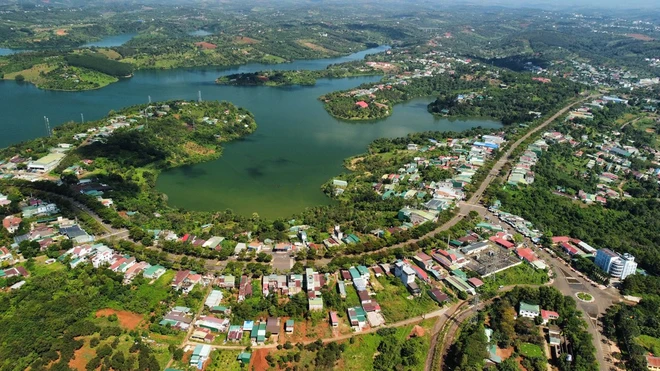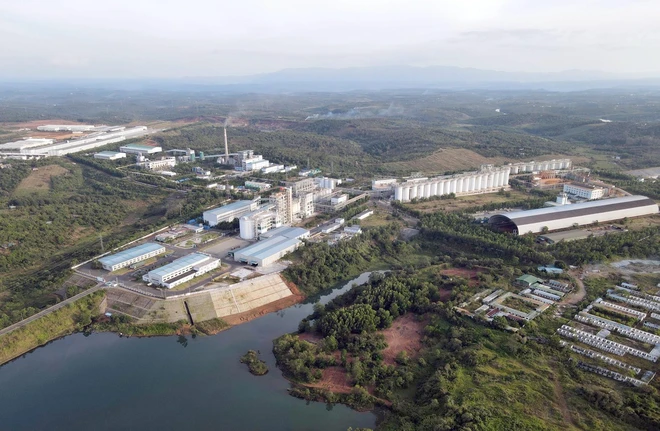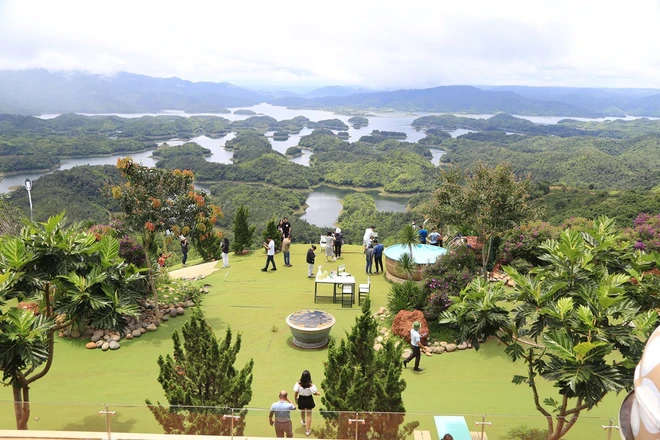Dak Nong has risen strongly after 20 years of establishment, construction and development
After 20 years of establishing the province, Dak Nong's gross domestic product (GDP) increased 24 times to VND 45,000 billion; per capita income increased 12 times, reaching over 60 million VND.

A corner of Gia Nghia city (Dak Nong province). (Photo: Vietnam+)
After 20 years of establishment, from a poor province with many difficulties and challenges due to a low starting point, Dak Nong has risen to become a bright spot in the socio-economic development of the Central Highlands in particular and the whole country in general.
Currently, Dak Nong is facing a great opportunity to develop strongly thanks to its rich bauxite resources, large reserves and the location of the connection between the Central Highlands provinces with the Southeastern provinces and Ho Chi Minh City.
According to Resolution No. 22/2003/QH11 dated 26/11/2003 of the 11th National Assembly on the division and adjustment of administrative boundaries of a number of provinces, on 1/1/2004, Dak Nong province was officially established.
Over 20 years of construction and development, with the attention, help and prioritization of resources of the central government, the efforts of the entire Party Committee and people of ethnic groups in the province have helped Dak Nong achieve many impressive achievements in the socio-economic fields. national defense and security and improving the quality of material and spiritual life for people from all walks of life.
According to the People's Committee of Dak Nong province, the economic growth rate in the province in the past 20 years has remained stable and sustainable, the scale of the economy is expanding, bringing Dak Nong out of the situation of a poor and underdeveloped province.
The gross domestic product (GRDP at comparative prices in 2010) is estimated to reach nearly VND 45,000 billion by the end of 2023, 24 times higher than in 2004, contributing to a significant improvement in per capita income/year. Currently, the per capita income of Dak Nong is over 60 million VND, 12 times higher than in 2004.

A corner of Nhan Co Alumina Factory - a pilot project for bauxite ore mining and alumina processing in Dak Nong, the province with the largest bauxite reserves in the country. (Photo: Vietnam+)
The total investment capital for the development of the whole society in 2023 will reach more than 18,600 billion VND, 20 times higher than in 2004; total budget revenue in 2022 will reach VND 3,500 billion, nearly 18 times higher than in 2004.
The rate of poor households by the end of 2022 is nearly 8%. In particular, the poverty reduction rate for local ethnic minority households has achieved impressive results. In 2023, Dak Nong will reduce poverty for local ethnic minority households by more than 3% compared to the target from the beginning of the year.
The value of industrial production in the period 2004-2023 is estimated at more than 116,000 billion VND. In which, in 2023, it is expected to reach nearly VND 14,200 billion, an increase of more than 30 times compared to 2004.
The highlight in the industrial development of Dak Nong province is the Nhan Co Alumina Factory project of Dak Nong Aluminum Company (Vietnam Coal-Mineral Industry Group). Currently, it accounts for about 40% of the value of industrial production, annually contributing nearly 400 billion VND to the local budget.
Dak Nong has been developing many hydropower projects and renewable energy industry. The province currently has 15 hydropower plants in operation, with a total capacity of nearly 360MW; more than 1,600 rooftop solar power systems, with a total capacity of nearly 400MW; two ground-based solar power plants, with a total capacity of more than 100MW.
Dak Nong also has six wind power plants under construction and operation, with a total capacity of 430MW, total investment of more than 15,000 billion VND.
For the agricultural sector, Dak Nong is developing comprehensively and strongly in both cultivation and animal husbandry. Although it is the province with the smallest natural area in the Central Highlands, Dak Nong is still a locality with an increasingly expanding cultivation area, increasing productivity and output; The livestock industry is developing in the direction of concentrated scale and high-tech application.

Ho Chi Minh Road (old National Highway 14) - the main road of Dak Nong province has been renovated, upgraded and put into use since 2015. (Photo: Vietnam+)
Specifically, the planting area of crops in 2023 is estimated at 320,000 hectares, nearly double that of 2004. Some crops occupy a large area and achieve high yields in the Central Highlands and the whole country.
Typically, pepper has an area of nearly 34,000 hectares, ranking first in the country; coffee currently has more than 141,000 hectares, ranking third in the country; the total pig herd is estimated at more than 500,000 heads; the total poultry flock is more than 3.2 million heads.
In the period 2004-2023, the export turnover of goods reached nearly 12 billion USD, of which in 2023 alone it is estimated at 1,271 million USD, an increase of nearly 25.6 times compared to 2004.
The main export items are coffee, cashew nuts, pepper, rubber, alumina and MDF products. The export market of Dak Nong province is increasingly expanding, currently exporting to 35 countries and territories.
After 20 years of establishment and development, Dak Nong is now considered a locality with a lot of potential for tourism development thanks to many natural landscapes and cool climatic conditions and fresh environment.
Famous tourist attractions of the province today are Ta Dung Lake, D'ray Sap - Gia Long waterfall cluster, especially Dak Nong Geopark, which has been recognized by UNESCO as a "global geopark."

A tourist destination along Ta Dung Lake, which is likened to Ha Long Bay on the Highlands. (Photo: Vietnam+)
From localities with weak and inconsistent transport infrastructure, up to now, the traffic network has been upgraded and completed, the rate of road plasticization in the province has reached 70% (compared to 14% in 2004); Ho Chi Minh roads (old National Highway 14); National Highway 28, provincial roads, and district roads have been upgraded and expanded.
In particular, the Gia Nghia (Dak Nong)-Chon Thanh (Binh Phuoc) expressway is currently being prepared for investment, which will create a strong motivation for Dak Nong in particular and the Central Highlands region in general to connect with the Southeast provinces and Ho Chi Minh City.
In order to make Dak Nong a developed province of the Central Highlands, with an average income higher than the national average and a locality with sustainable development, a civilized society and a unique and loving culture according to the Plan issued by the Dak Nong Provincial Party Committee in June 2023, Dak Nong identified three strategic breakthroughs, which are also three groups of key solutions to implement.
Three groups of key solutions include: Strongly improving the business investment environment, effectively managing and using all resources for development; building infrastructure, focusing on roads; and develop human resources, especially leaders, managers and branches and fields that are the pillars of local economic development./.
Vietnam News Agency in collaboration with the Department of Information and Communications of Dak Nong